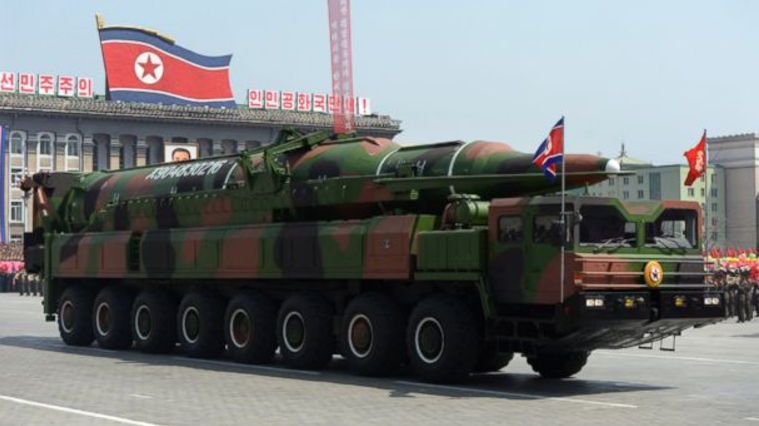 Parler
Parler Gab
Gab
- North Korea fired a ballistic missile that flew over the Sea of Japan before landing 200 nautical miles outside Japan's exclusive economic zone (EEZ).
- The launch demonstrates Pyongyang's advancing missile technology, including short-range ballistic missiles (SRBMs) and potential hypersonic capabilities, defying international sanctions.
- This follows multiple recent tests, including nuclear-capable cruise missiles and hypersonic missile claims, seen as direct responses to South Korea's planned nuclear submarine acquisition.
- Despite Trump's offers for talks, North Korea refuses negotiations unless the U.S. drops denuclearization demands, accusing Washington of "antagonizing" the regime with sanctions.
- Japan, South Korea and the U.S. vow a "strong response," while Germany condemns the launch. Experts warn of potential nuclear tests and further provocations, signaling Kim Jong Un's defiance.
A pattern of provocation
This latest launch follows a series of recent missile tests. In October 28, North Korea tested nuclear-capable sea-to-surface cruise missiles while U.S. President Donald Trump met with Prime Minister Takaichi in Tokyo. Earlier in October, Pyongyang fired multiple short-range ballistic missiles, including what it claimed was a hypersonic missile, just days after Trump's visit to South Korea. Analysts suggest these tests are a direct response to South Korea's plans to acquire a nuclear-powered submarine—a move that North Korea perceives as a direct threat. Ahn Chan-il, a defector-turned-researcher at the World Institute for North Korea Studies, explained: "From North Korea's perspective, the possibility of sudden attacks from the East Sea will be a source of anxiety. If South Korea acquires a nuclear-powered submarine, they would be able to enter North Korean waters and preemptively monitor or intercept weapons such as submarine-launched ballistic missiles." The missile launch comes amid stalled diplomatic efforts between Pyongyang and Washington. Despite President Trump's renewed offer to meet with North Korean leader Kim Jong Un, no summit has materialized. Trump, who previously held historic talks with Kim in 2019, reiterated his willingness to negotiate during his recent trip to the Indo-Pacific region. However, North Korea has remained defiant, insisting that talks will only resume if the U.S. drops its demands for denuclearization. On Thursday, Nov. 6, Pyongyang's foreign ministry accused the Trump administration of "antagonizing" the regime by imposing sanctions over alleged money laundering activities.International condemnation
Germany swiftly condemned the launch, with the German Foreign Office stating: "We urge the DPRK to immediately stop the unlawful development, test & transfer of ballistic missiles, as requested by multiple UNSC Resolutions." Meanwhile, Japan and South Korea have vowed a "strong response" with both nations coordinating closely with U.S. military and intelligence agencies. The Department of War has reaffirmed its commitment to deterring North Korean aggression, despite calls for more "flexibility" in military strategy. With North Korea accelerating its weapons testing, experts warn that Pyongyang may be preparing for larger provocations, including a potential nuclear test. The stalled diplomacy between Trump and Kim suggests that any future negotiations will be on Pyongyang's terms—further complicating efforts to rein in the regime's nuclear ambitions. As tensions rise, the international community remains on high alert, with Japan, South Korea and the U.S. closely monitoring North Korea's next move. One thing is clear: Kim Jong Un is sending a message—and the world is listening. Watch the video below about North Korea launching a missile over Japan. This video is from the Chinese taking down EVIL CCP channel on Brighteon.com. Sources include: SputnikGlobe.com JapantTimes.co.jp BrightU.ai Reuters.com DW.com Brighteon.comChina accuses Philippines of provoking tensions in South China Sea amid rising military alliances
By Belle Carter // Share
Japan and U.S. forge rare earth alliance to break China’s stranglehold on critical minerals
By Ramon Tomey // Share
The great NGO purge: Layoffs hit 22-year high as funding freezes amid RICO threats
By Willow Tohi // Share
China’s rare earth DOMINANCE threatens U.S. prosperity
By Lance D Johnson // Share
U.S. surveillance flights over Mexico signal escalating cartel crackdown under Trump
By Belle Carter // Share
Turkey issues arrest warrants for Netanyahu and other Israeli officials over Gaza genocide
By kevinhughes // Share
Streamlined federal dietary guidelines DELAYED amid government shutdown
By kevinhughes // Share
Sweden REPEALS uranium mining ban in bold shift toward energy independence
By ramontomeydw // Share
Texas AG Paxton takes Roblox to court, slams gaming platform as "breeding ground for predators"
By ramontomeydw // Share
North Korea escalates tensions with latest ballistic missile launch over Japan
By kevinhughes // Share
Vinegar: The surprising natural remedy for depression symptoms
By newseditors // Share










